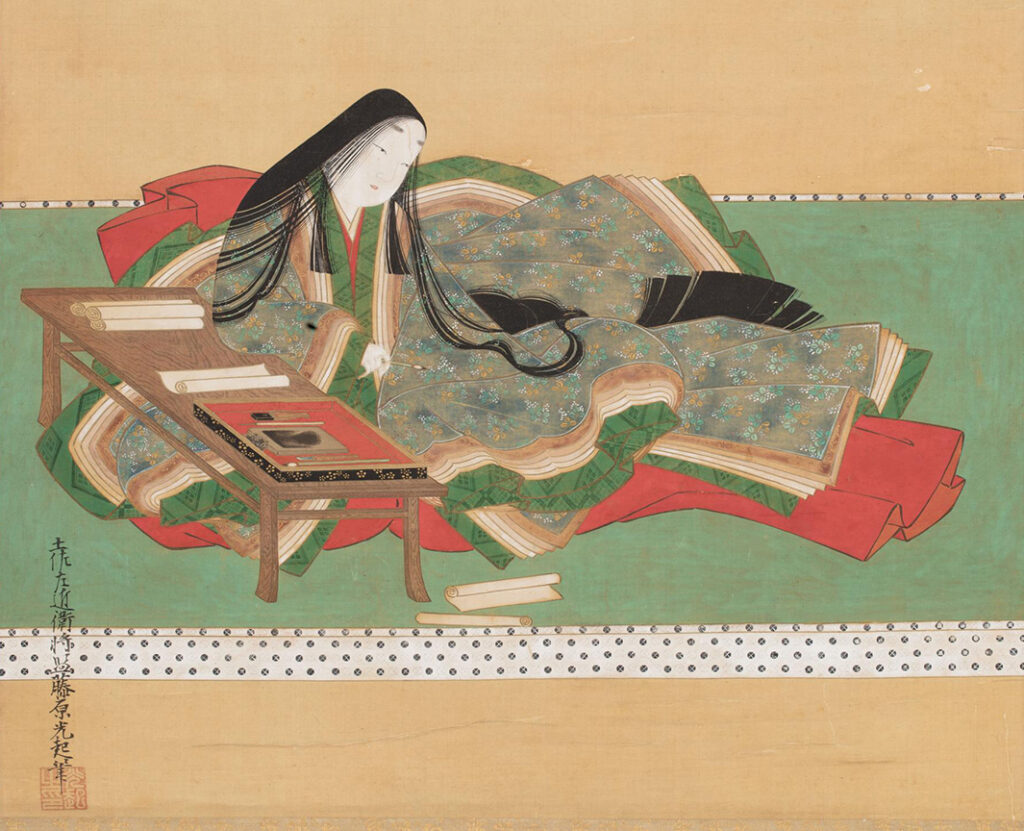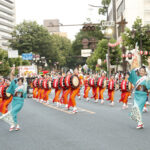

紫式部 Murasakishikibu
ca. 970 – 1014
Author of the world’s oldest full-length novel
Murasaki Shikibu, a Woman of Many Mysteries
The exact year of Murasaki Shikibu’s birth and death are not known. Furthermore, the name “Murasaki Shikibu” is not actually her real name. In the Heian period, unless a woman was a consort or a child of the emperor, her real name and the year of her birth and death were often unknown. It is said that she came to be called Murasaki Shikibu after “Murasaki no Ue,” a character in her story “The Tale of Genji.”
We don’t know her birth or death date, we don’t know where her grave is, and although she left a diary, she never revealed her true story.
Not much is known about her life. This is because not many people in Japan during her lifetime could read and write. Therefore, records about her are few and uncertain. But still, the reason she is famous in Japanese history is for her writing “The Tale of Genji,” which is considered the oldest full-length novel in the world. In this article, we will be introducing parts of her life while also exploring “The Tale of Genji.”
“The Tale of Genji”: A Novel about Love and Hate
“The Tale of Genji” is a very long novel, with about 2,400 pages of 400-character manuscript paper, a volume that would surprise even novelists today. It is divided into 54 chapters, each named “Kiritsubo’’ or “Wakamurasaki.”
The main character is Hikaru Genji, who was born as a prince of the emperor. Due to his mother’s low status in society, he left his position as a member of the imperial family, partly because of the emperor’s consideration that he would not be able to endure a battle for succession in the court. The story highlights his love affairs with various women, his friendships, and his competition for success in the court. The story spans a long period of 70 years, from the time of his death to stories of his own children and grandchildren, with the appearance of about 500 characters. About 800 waka poems are presented.
The story is set in an aristocratic society where everyone has ambitions for power. In this environment, the characters search for love. When things don’t go their way, they are envious. The author, who questioned herself about what it meant to be a human and what the meaning of life was, filled the story with her own life and emotions. Even today, this 1,000-year-old novel still fascinates many people.
Murasaki Shikibu, the Author
Questions have been raised as to whether she really wrote this novel, as the research has been slow to find evidence as to why she even decided to write this book. It does not have the author’s name on the cover, as books do today. But despite that, this book was originally written by Murasaki Shikibu, copied by an aristocrat, and then copied again by someone else.
Murasaki Shikibu’s Life
Although there are many uncertainties about her life, here is what we know about her with the research we have today.
Murasaki Shikibu was born into a noble family in the middle of the Heian period. Her father was a scholar of Chinese literature, so he taught Chinese literature to her elder brother, who found it difficult. She always watched her father when he was teaching her brother and eventually understood it better than he did. However, at that time, only men were allowed to learn Chinese literature, so seeing Murasaki learn it more quickly than her brother, her father regretted, “If she were a boy, she would be a great scholar in the future.”
During this time, it was not socially proper for men to brag about their knowledge, so she knew that if she, as a woman, tried to flaunt her knowledge, her life would be miserable. Therefore, she never revealed her knowledge of Chinese literature and pretended that she could not write a single Chinese character.
Murasaki Shikibu and “The Tale of Genji”
When she was 26 years old, she got married and had a baby girl. However, only two and a half years after her marriage, her beloved husband died of an illness. It is believed that she began writing “The Tale of Genji” around this time. She was pessimistic about her future. Losing hope, the lonely woman began to write.
And then, she was hired by Fujiwara no Michinaga to tutor his daughter in the imperial court. There, she constantly witnessed power struggles. For example, aristocrats tried to marry off their daughters to the emperor in order to gain political power. She observed these people carefully.
In the Imperial Palace, Emperor Ichijo and other people were reading “The Tale of Genji,” which was in the process of being written, and Michinaga would visit Murasaki’s room and say, “I can’t wait to read the rest of it!” Many people were looking forward to her work.
Eventually, “The Tale of Genji” took about 10 years to complete, and it seems that it was completed while she was in the service of the palace.
Sometime later, she left the court. Her daughter who was famous for her many romantic conquests succeeded Murasaki Shikibu in the service of Akiko.
In her own diary, she wrote: “Writing stories is a good thing. Writing stories begins with the need to express all the human events, good and bad, that I aspire to tell people for many years to come.”
As a woman, in a time when being talented and educated was not considered a good thing, she nevertheless continued to write stories, and her ambitions and way of life give courage to women, and indeed to all people, in society even to this day.
.
.
.
.




